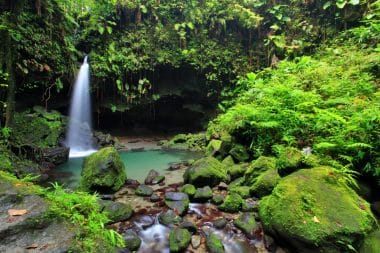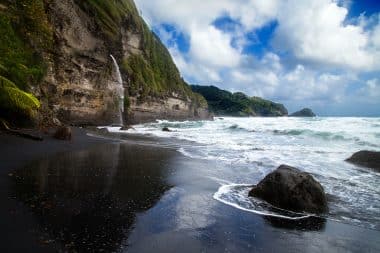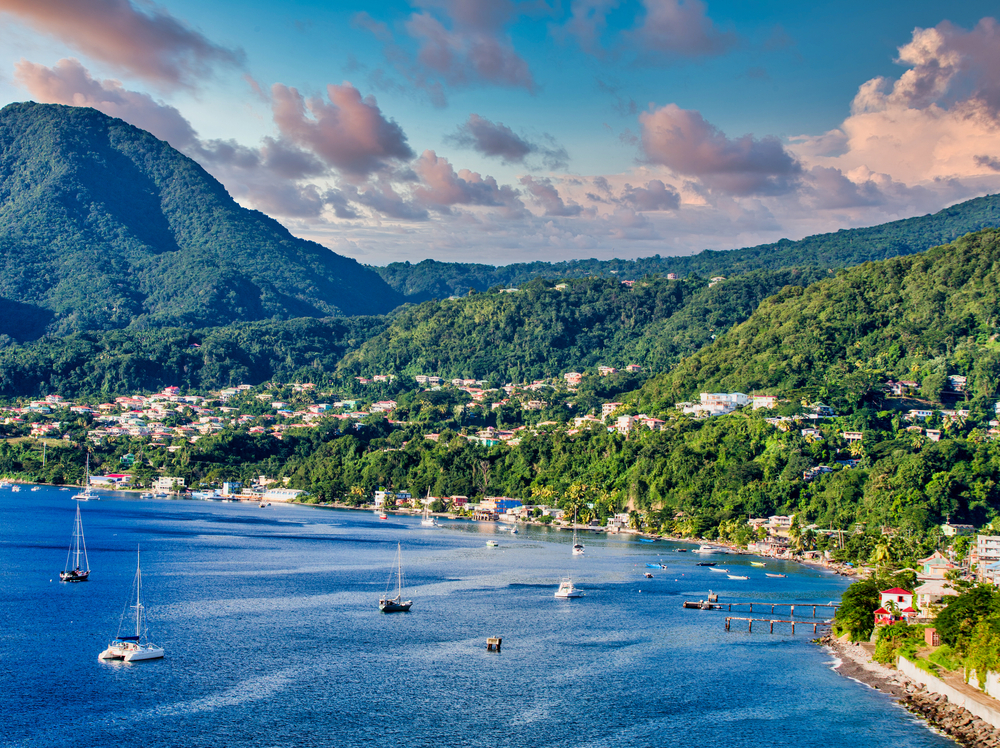Between the well-known Caribbean islands of Martinique and Guadeloupe lies the rather unknown island of Dominica. The island paradise still offers an original Caribbean atmosphere away from mass tourism. Holidaymakers who come to Dominica experience pure adventure: spectacular scenery, exciting hikes and a mystical backdrop known from Hollywood films make the island a true pearl of the Caribbean. An important factor for this magnificent nature is certainly nature conservation. This is taken very seriously in Dominica. For example, there is a “Cleaning Day” and children are taught respect for animals as early as primary school.
The typical beach holiday with an all-inclusive offer does not necessarily exist here. Nevertheless, beach lovers also get their money’s worth and discover natural beach diversity. There are beaches with white sand, beaches with black sand but also rocky sections, some of which can only be reached by four-wheel drive vehicles.
Through the jungle to the Emerald Pool

Volcanoes and rainforest characterize Dominica’s islandscape. On the island, which is only 50 kilometers long and 22 kilometers wide, 2,200 indigenous people (called Kalinago) still live today and Creole is partly spoken. At the village of Bataka their territory begins. Here they maintain the old customs and offer visitors an insight into the original life on the island with a tour of the museum village.
Visitors can also become aware of this originality on an adventurous trip to the Emerald Pool, for example. From 12 meters, the water rushes thunderously down the waterfall into the lake below, which invites you to swim with its beautiful emerald green water in an almost clichéd setting. To reach this special place, however, you first have to make your way through the jungle.
Natural spectacle in the Morne-Trois-Piton National Park
The Morne-Trois-Piton National Park also shows how unique nature is in Dominica. Nestled in a rainforest that shines in a wide variety of shades of green, the volcano of the same name rises into the sky. The unique habitat has been declared a World Heritage Site by UNESCO. A cloud forest, waterfalls and magnificent lakes complete this special place. Another exciting experience is swimming through the Titou Gorge.
Dominica – Hike through sulphur flows to the boiling lake
On Dominica, vacationers will find the second largest boiling lake in the world. The Boiling Lake has a diameter of 63 meters and can only be reached via a hike. This is quite demanding. In about six hours, it leads through the Valley of Desolation, where geysers, steam springs and sulphur flows await hikers.
In the footsteps of Jack Sparrow
The filmmakers also discovered that Dominica offers adventurous backdrops. And so film scenes for the second part of “Pirates of the Caribbean” were shot here. In the film, adventurers meet a witch. She lives surrounded by mangroves in the swamps. These scenes were shot on the Indian River in Dominica. A small witch’s hut from the original setting remained there. It blends perfectly into the image of nature and is reminiscent of the spectacle at the time of filming. It can be seen well on a boat tour on the Indian River.
Variety for beach lovers
As mentioned at the beginning, there are different beaches on Dominica. And even if not everyone gives the typical dream beach picture, each one has its own special charm.

Champagne Reef is an almost paradisiacal destination, especially for divers and snorkelers. Steep cliffs and fascinating volcanic formations make for an impressive picture. In the water, in addition to the colorful variety of sponges and fish, there is another special phenomenon to marvel at: volcanic activity is still taking place in some places. Gases escape. This creates small bubbles and gives the impression that you are swimming in a glass of champagne.
Palm trees line the black sand beach of Rosalie Bay. There is rough surf here, so it is more suitable for sunbathing and enjoying nature than swimming. Sea turtles also have their home here.
To get to Hampstead beach, you need a four-wheel drive vehicle, because the road there is very rough. Instead, visitors can expect a golden sandy beach with calm sea. This is the perfect place for a picnic in the shade of white mangroves and coconut trees.
A real Caribbean postcard motif is Batibou Beach. The fine powder sand invites you to take a walk. Gentle waves play around your feet and in the background you can see green hills. Of course, such a backdrop does not lack the tall palm trees, under which you can enjoy drinking from a coconut. If you get a little hungry, the Rainbow Beach Bar offers not only Caribbean delicacies, but also a fantastic view.
Getting to Dominica
If you want to visit this special island, the best way to reach Dominica is by plane. However, there are no direct flights from Germany or Europe in general. Flights are possible, for example, from Frankfurt am Main via Guadeloupe or Martinique. From there there are domestic flights and also ferry connections to Dominica. In addition, the island is one of the destinations of a Caribbean cruise for some shipping companies.
Roseau – The island’s capital
The Cultural Treasure Chamber: Roseau’s Historic Sites
A city with deep-rooted historical and cultural roots, Roseau is home to some of the best-preserved examples of colonial architecture in the entire Caribbean. A must-see is St. Patrick’s Catholic Cathedral, whose origins date back to 1730. After a devastating earthquake, the cathedral was rebuilt and now serves as a central point for the Catholic community on the island.
Not far away is the Dominica Museum, which is housed in a carefully renovated colonial building. It offers insights into the island’s natural history, culture, and pre-colonial past.
Natural wonders: recreation and adventure
Roseau is surrounded by natural wonders just waiting to be explored. Trafalgar Falls, just a few miles east of the city, offers stunning views of two adjacent waterfalls plunging into the depths. Another highlight is the Roseau Botanical Garden, a peaceful sanctuary that’s home to a variety of tropical plants and even rare species of parrots.
Culinary Roseau: A Taste of Dominica
The gastronomy in Roseau is a delicious fusion of Creole, African and European influences. Sample local specialties such as Callaloo soup or crab back, a dish that serves crab meat with spices in the shell. A visit to Roseau Market offers the opportunity to buy fresh, local produce directly from the farmers and enjoy the lively atmosphere.
Events and festivals: The cultural heart beats
Roseau is the center of social life in Dominica. The annual World Creole Music Festival attracts visitors from all over the world and celebrates the island’s diverse music scene, from zouk to reggae. The colourful Carnival, known as Mas Domnik, is also a deep-rooted celebration that celebrates the island’s cultural heritage through parades, music and dance.
Practical tips for your visit to Roseau
- How to get there: Roseau is accessible via Douglas-Charles Airport and Canefield Airport, with further connections via ferries from neighbouring islands.
- Accommodations: From cozy inns to luxurious resorts, Roseau offers a wide range of accommodation.
- Transportation: The city is compact and can be easily explored on foot. Taxis and minibuses are also available for longer distances.
The most important facts
- General information:
- Official name: Commonwealth of Dominica
- Capital: Roseau
- Population: about 73,000 inhabitants
- Official language: English; a Creole dialect (patois) is also widely spoken.
- Currency: Eastern Caribbean dollar (XCD)
- Time zone: UTC -4
- Geography:
- Area: 751 square kilometers
- Dominica is often referred to as the “Nature Island of the Caribbean” because of its lush landscape and rich biodiversity.
- The island is known for its mountains, natural hot springs, and tropical rainforests.
- Climate:
- Tropical climate with little seasonal temperature variation.
- Rainy, especially between June and November.
- Economy:
- Economically based on agriculture, tourism and as an offshore financial services center.
- The main export goods are bananas, soap, bay oil, vegetables, grapefruit and oranges.
- Tourism:
- Popular attractions include the UNESCO World Heritage-listed Morne Trois Pitons National Park, Boiling Lake, Trafalgar Falls, and numerous diving spots.
- The island offers excellent opportunities for ecotourism and adventure activities such as hiking, bird watching, and snorkeling.
- Cultural:
- Dominica hosts the World Creole Music Festival every year.
- The culture is a mix of British, French and African influences, which is reflected in the music, dance and festivals.
- Transport:
- International airports: Douglas-Charles and Canefield Airport, however, most international connections are via nearby islands such as Guadeloupe and Martinique.
- Politics:
- Political system: Parliamentary democracy within the framework of the Commonwealth.
- The head of state is the president, currently Charles Savarin.
What are the entry requirements for Dominica?
- Travelers need a valid passport that is valid for at least six months beyond the date of departure. Temporary passports and children’s passports are also accepted, but the identity card is not sufficient.
- A return or return ticket is required.
- For a stay of up to 90 days, no visa is required for citizens of most European countries, the USA and other selected countries. Citizens from the Commonwealth of Nations, CARICOM member states and countries such as Austria, Germany and other European countries are allowed to enter the country without a visa. However, some countries, including Haiti and the Dominican Republic, require a visa.
- Cruise ship passengers who stay on the island for less than 24 hours do not need a visa.
It is recommended to check with the relevant embassy or official websites before traveling, as entry requirements may change.
The climate of Dominica
| Month | Through. Maximum temp. (°C) | Through. Low temp. (°C) | Precipitation (mm) | Rainy days |
|---|---|---|---|---|
| January | 28 | 21 | 150 | 18 |
| February | 28 | 21 | 100 | 12 |
| March | 29 | 21 | 90 | 11 |
| April | 30 | 22 | 60 | 9 |
| May | 31 | 23 | 60 | 10 |
| June | 31 | 23 | 100 | 12 |
| July | 31 | 23 | 150 | 18 |
| August | 31 | 23 | 180 | 19 |
| September | 31 | 23 | 180 | 20 |
| October | 31 | 23 | 210 | 21 |
| November | 30 | 22 | 250 | 22 |
| December | 29 | 21 | 240 | 22 |


